I’m extremely disappointed right now. When I read a manga called Amnesia Labyrinth, I expect to see someone wake up in a maze without any memory of how they got there. That’s not what this is at all!
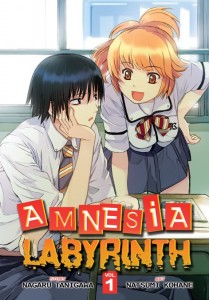
Sarcasm aside, Amnesia Labyrinth isn’t nearly as exciting as its intriguing name would suggest. The series has just hit American shelves in graphic-novel format courtesy of Seven Seas Entertainment, and I can’t say I was riveted by the four chapters included in this first volume. In fact—and I know I sound like a bit of a bastard for starting out the review this way—the volume peaks in its first three pages. You look at the catchy (if misleading) cover, read the synopsis on the back, and settle down to read a good ol’ mystery manga about a couple of high-school kids. And what’s the first thing to happen in the volume? An innocent student gets shoved in front of an oncoming train.
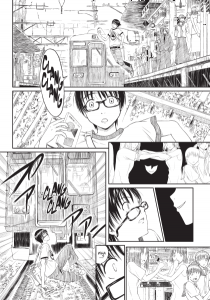
That’s…unexpected…
It’s a shocking way to open the volume, and certainly grabs your attention, but by the end of the first chapter, all pent-up excitement brought on by the opening homicide has more or less evaporated. The series gets better from there—the first chapter is pretty awful—but at least in these four chapters, the story is never as gripping as it is in those first few pages.

Amnesia Labyrinth follows Souji Kushiki, a high-class student from a wealthy family, who returns home from boarding school to run the household after his older brother, Kazushi, disappears. His three younger sisters—Youko, Harumi, and Saki—are all eager to see him…a little too eager, in fact. Something strange has come over his disturbingly over-affectionate sisters, and when Souji learns that three students from his local class were murdered over the summer, he begins to get suspicious. The murders are brought to his attention by one of his classmates, Sasai Yukako, sole member of the school’s Intelligence Committee. She’s determined to track the killer down, and at her insistence, Souji reluctantly teams up with her to solve the mystery.
I could easily rattle off some of the problems I had with the story, but luckily, author Nagaru Tanigawa did it for me! In a “Message From the Writer” at the back of the volume, he writes: “Although an overall plot does exist for this story, when everything was said and done, I sort of ran out of things to write, and therefore I admit there are a number of lazy, phantom passages scattered throughout.”

That pretty much describes Amnesia Labyrinth in a nutshell—although I was very surprised to see the author essentially apologize for the narrative woes. There’s certainly a plot to the story, but it’s doled out lazily and with total disregard for the reader’s attention span. Relatively simple exposition like why Souji had to come home or his family background seems needlessly complex, and there are details listed clearly on the cover description that never become anything more than hazy throughout the volume. In the span of these four chapters, the plot progresses minimally, and the only real forward momentum in the ‘mystery’ comes in the form of a sudden M. Night Shyamalan-esque twist in the last few pages. As for the ‘phantom passages’ Tanigawa writes of, they certainly exist; many stretches, particularly in the first chapter, are overlong and ramble, while many small scenes or details seem completely inconsequential. Granted, I don’t know how the story will ultimately turn out, but in the span of this first volume, there’s an awful lot of dead space, and that’s not much fun to read.
Ultimately, though, the manga’s cardinal sin comes in the character department. I could certainly complain about Souji being ‘emo’—he has black hair, he broods and sulks, he’s completely antisocial, you can imagine a long, drawn out sigh at the end of his every sentence, etc.—but more importantly, he’s just boring. He has absolutely zero personality, he’s not likable, and he’s so generally underdeveloped that if I didn’t have the manga in front of me right now, I probably wouldn’t remember his name. He doesn’t even have any discernable character traits (well…beyond being emo…), except for the ones other characters assign to him. For instance, we’re told over and over again that he’s a brilliant student and a talented athlete, but at no point do we see him perform any feats of mental strength or show off his athleticism. The only reason I have to believe that Souji is smart or athletic or loved by his female peers is because other characters say so, and that’s not a good substitute for true character development.
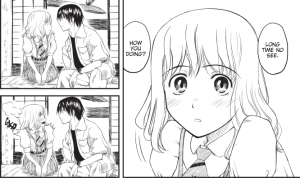
It doesn’t help that he seems completely disinterested in every single thing that’s going on around him, because to be honest, his life is far from boring. His sisters have slightly more personality, but that may only be because they’re all super horny for their big brother. Yes, you read that right—once Souji comes home, all three of his sisters start making moves on him, and at no point, from start to finish, does Souji’s countenance change. It’s clearly not their normal behavior—Souji at least mentions that—but he seems as surprised by their odd sexual urges as you or I would be if we casually glanced down and noticed our shoe was untied.
Granted, one of his three sisters is technically a stepsister, and another a half-sister (provided I’m correct about that—the series is wildly unclear about all this) but still…it’s strange. It’s the kind of strangeness that you prepare for when reading manga, but shouldn’t Souji be somewhat cognizant of what the word ‘incest’ means? Not to spoil anything, but in the third chapter, we learn that Souji definitely does know what that word means…and that’s when things get weird. Surprisingly, the revelation doesn’t make Souji any more interesting.

The manga’s strongest character is undoubtedly Sasai, the intrepid intelligence-enthusiast who convinces Souji to help her catch the mysterious murder. She’s spunky, cute, and has an honest-to-God personality. The manga is at its most interesting when she appears, though, ironically, she makes no impact on the story whatsoever in these first four chapters, and I have yet to see what importance her role will serve in the narrative.
In the end, Amnesia Labyrinth is an underwhelming mess of bland characters, poorly paced and uninvolving story, and odd sexual scenarios. The writing isn’t always bad, and it’s never actively awful. There’s a discussion between Sasai and Souji about death in Chapter 4 that’s actually really well composed and serves as the height of the volume’s creative achievement. It falls somewhere in the middle, and the middle isn’t very exciting at all.
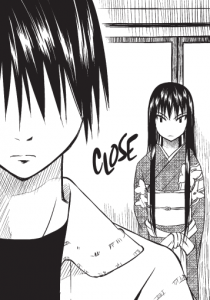
On the flipside, Natsumi Kohane’s artwork is gorgeous. It’s lavishly detailed, wonderfully realistic, and has a strong sense of depth and dimensionality. I didn’t find Amnesia Labyrinth very fun to read, but it’s a marvel to look at. The cover art is actually one of the more underwhelming drawings in the volume, as it gives almost no indication of the manga’s tone or story. But then again, I’m not sure what image would sum up the plot.
Seven Seas’ translation work is also excellent. I obviously can’t speak to the accuracy, but there’s absolutely no Americanization of any kind, and the writing is fluid and natural at all times. If anything, the translations are just a bit too accurate at some times. Many Japanese words or phrases are left untranslated and without a footnote to help decipher, and that can be confusing, especially early on when you’re still trying to learn all the names. For instance, the sisters all call Souji ‘Niisan,’ Japanese for older brother, and Souji, in turn, calls his missing brother ‘Niisan.’ The word seemed familiar to me, but because I don’t speak the language, I didn’t immediately recall it, and for a long time, I was sure they were referring to another character entirely. A simple footnote would solve this problem. There is a glossary of some terms in the back, though ‘Niisan’ is not included and you wouldn’t know the glossary was there when reading through the first time.
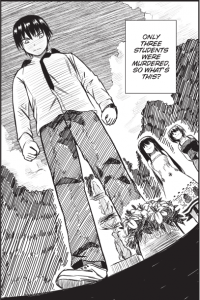
As you can tell, I wasn’t impressed by Amnesia Labyrinth, and I’m left with no compelling reason to continue following this story. Heck, if it wasn’t for professional obligation, I probably wouldn’t have made it through Chapter 1. There are some redeeming values, like the artwork, but overall, this isn’t something I can recommend. If you’re a fan of the author or artist or feel intrigued despite my negativity, do know that this is a very solid domestic publication; you can even buy it at some online retailers, like Amazon, for a highly reduced price.
Story: D+
Art: A
Cover: B
Translations: B+
This manga was reviewed using a digital screener. Copyright information is under the ad.
Amnesia Labyrinth – © 2009 Nagaru Tanigawa, Kohane Nasumi. Translation rights arranged with ASCII MEDIA WORKS. Published by Seven Seas.










